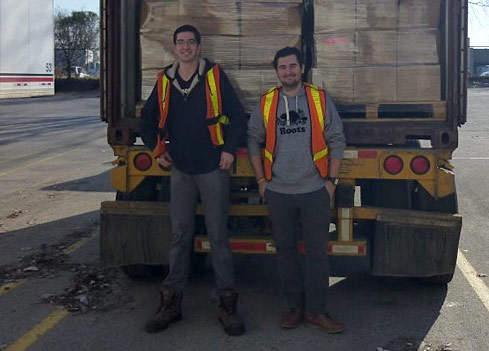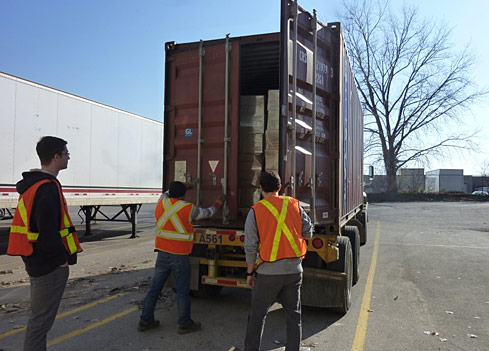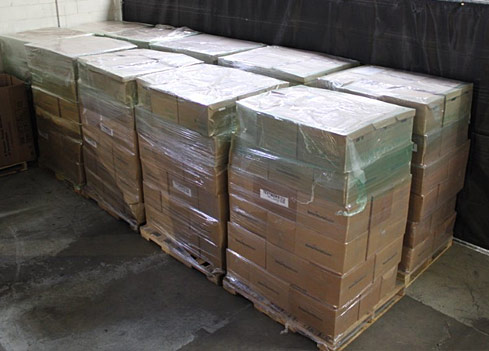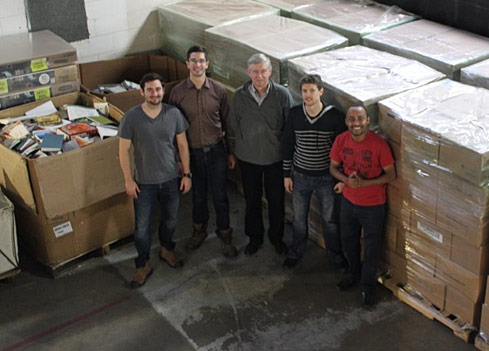As part of the 39 Country Initiative at Ivey, a container of educational materials—including books, journals, cases, and course packs—was shipped to the business school at Addis Ababa University, Ethiopia, on July 25, 2013. This note summarizes the practical learning accumulated about preparing for and effecting an overseas container shipment. Without proper planning, the shipment of a container will take a lot more time, energy, and money than it should. To address each activity in the process, the discussion is organized in four parts as follows.
The packing and storage of the materials should be based on prior planning. If materials are packed in loose boxes and/or in boxes without lids, they will need to be unpacked and later repacked in new boxes. Boxes should not be overfull, nor below capacity. Use of boxes of different dimensions will cause trouble when loading the boxes onto pallets. Generally, in the process of packing and storing materials for eventual shipment, the following issues need to be considered:
- Plan ahead to collect empty boxes, preferably of equal, or at least comparable sizes
It is important to have enough empty boxes at hand to accommodate loose books or replace boxes that are in bad shape. Doing so facilitates proper storage, efficient use of storage space, and avoids unnecessary last minute repacking. Using boxes of similar dimensions allows for easier and more efficient loading. Plus, shipping agencies require you to tell them about the dimensions (i.e., length, width, and height) of the boxes used. Using boxes of different sizes caused problems while stacking the boxes onto pallets. - Assign responsibilities
Responsibilities need to be assigned for collecting the materials, unpacking and repacking boxes, properly and efficiently storing them, and regularly keeping track of weight and number (e.g., in boxes) of the shipments. Shipping agencies require the number of boxes and the total weight of the shipment to calculate associated shipment costs.
- Find a storage room and get it ready
The storage room ought to be in a building that has a loading dock. For efficiency and movability reasons ideally the room should be located close to the loading dock. If the storage room houses materials not related to the shipment, it would be wise to put them in a corner where their interference with the storage of your materials is minimal. If the storage room holds other materials such as used office equipment in addition to the educational materials, mobility inside the room will be limited severely.
If there is access to pallets or skids, loading the boxes right there and then will save time and unnecessary energy expenditure. In doing so, make sure a) you stack the boxes by alternating their directions to minimize shifting, tilting, and/or collapsing, and b) to allow enough room between each stack and between a stack and a wall to shrink-wrap the piles more easily and efficiently. Pallets need to be heat-treated so that they will not be a carrier of invasive species of insects and plant diseases. They must carry the appropriate ISPM stamp as proof. Without it, customs will not allow the container to be shipped. - Keep tape and a pair of scissors on hand for use in the storage room
You may find it appropriate and more efficient to bind boxes with some minor cracks than to unpack them. Plus, if you will be doing the shrink-wrapping yourself, you will need tape and a pair of scissors.
Another important issue in the process of shipping a container of goods is determining the right shipping agency to work with. Such shipment can be handled either by a freight company or by a moving company. In fact, deciding which service to use is useful even in preparing for the shipment as these companies differ in the type of service they provide.
- Decide the kind of service you want to get
Usually, moving companies provide a more comprehensive service of palletizing, shrink-wrapping, transporting from storage to loading dock, loading the shipment onto a container, and eventually shipping it to its destination. As such, the customer is required only to properly pack the shipments and get them ready for pickup. Moving companies require the contact address of a customs agent of the consignee at destination. As such, the party at the receiving end needs to have a customs agent with whom it has a working relationship. Parties that are not actively involved in the importing business, as is Addis Ababa University, may not have such connections, so they need to get one.
On the other hand, usually the service offered by freight companies includes only sending a truck and container to your premise (i.e., to the loading dock) and you will have to palletize and shrink-wrap your shipments. Similarly, inside pickup or delivery, loading, and unloading will be your responsibilities. If asked to perform these tasks, the freight company will require additional payment or direct you to another packaging company. As a result, freight companies are likely to give you lower price than do moving companies. Unlike moving companies, freight companies might not ask for a contact address of a customs agent at the destination port as they tend to have their own customs agents there. - Contact people who have experience in international shipment to refer you to trustworthy companies and guide you along the process
International shipment is a difficult undertaking for a novice to embark upon. Hence, having the support of an individual who has done it a number of times will serve you well. Plus, proper delivery of your shipments requires that you be careful in selecting companies to work with. - Identify at least three shipping companies to request quotes from and compare
It is important to collect quotes from several companies. However, your focus should not only be on the amount of the quote. Instead, what is even more important is to look into the details and see what is included and what is not. A quote that looks lower may get higher when missing services are included. - Before contacting shipping companies, make sure you have on hand the information they require
Information about the size, estimated weight (i.e, 400 boxes at 20 kg each), and number of the shipments is necessary to determine the quote. As such, you need to have this information ready. In addition, be ready to tell them the destination port or country, the pickup location and address, and whether it is a one off or a regular shipment. - Ask the shipping companies to inspect the shipments
This will give them an idea about the shipment and help them in setting the right quote. Alternatively, you can e-mail them some photos.
- Packing List
This document is prepared by you (the shipper) and contains information about the contents of the shipment. By reading through the packing list, interested parties will gain information about what is included in the shipment. - Bill of lading
This is a document with which you transfer ownership of property to the consignee. Prepared by you, the document contains information about the consigner, the consignee, and the specifics of the shipment (for example, quantity, type, and weight of the shipments). It requires the shipping company to transfer title of ownership to the named consignee at the destination. - Export Declaration Form
The B13A form is required by the Canadian Customs Authority if the declared value of the shipment is CAD $2,000—or more. The first page is to be filled out by you and the rest by the shipping company. Once completed, the form is submitted to Canada Customs for authorization. Authorization may take up to two days from the date of submission of the form. It is not required if you send your shipment as a donation which has a value of less than CAD $2,000. Specifics regarding the Export Declaration Form will vary by country of origin. - Commercial Invoice
This document is prepared by you for customs purposes. Calculation of tariffs is based on this document. In our case, we prepared a commercial invoice in which we specified that the goods shipped were donations for Addis Ababa University, Ethiopia. The invoice included information about the consignee and the consigner, the commodities shipped, the country of manufacture, the commercial value of the shipment, among others. - Insurance quote form
Insurance is calculated based on what the shipment would cost in the destination country. In our case the rate was $0.25/$100 of total insured value. (We asked people in Ethiopia to estimate the local commercial value of used teaching material.) Once the form is completed, it will be sent back to the shipping company. Buying insurance for the shipment is optional. - A written acceptance of the shipments by consignee
Before the shipping company accepts the shipment, it requires a written statement from the consignee confirming their commitment to receive the shipment. - Booking confirmation
Once the payment for the shipment service is received, the aforementioned documents completed, and the consignee’s confirmation of receipt obtained, the shipping company issues this document showing, among other things, the pickup date and the estimated arrival date at the destination.
In the event that the shipping company does not provide these services or if you want to save money, you will have to palletize the boxes, shrink-wrap the stacks, and load them onto the container.
- Mobilize people to help with stacking boxes onto pallets, shrink-wrapping, and loading onto the container.
- Use shrink-wrap. The number of rolls of shrink-wraps to use depends on the number of pallet stacks you have. In our case, for example, we had nine stacks and needed roughly three rolls of shrink-wrap.
- Arrange for access to a pallet lifter to move stacks from the storage room to the loading dock and into the container.
- Measure the dimensions of the stacks on each pallet, mark each stack, and specify the order in which they need to go into the container. It is important to consider the internal dimensions of the container when determining the efficient arrangement of the stacks in the container. For example, the internal dimensions of a standard 20’ container are: Length: 5,897 mm; Width: 2,348 mm; Height: 2,385 mm, and for the door opening: Width: 2,337 mm; Height: 2,272 mm. Due to lack of enough heat-treated pallets of a common size, we were forced to use pallets of different sizes—a combination of 106.7 * 106.7 centimetres and 121.9 * 101.6 centimetres.
- You will have limited time to load the container (in our case we had only two hours) before additional charges apply. Thus, it is in your best interest to move the stacks closer to the loading dock before the shipping truck arrives, and solicit the support of others to help with loading.
- The loads on each pallet need to be shrink-wrapped to ensure their stability. In addition, shrink-wrapping helps avoid humidity/moisture from getting into the shipment while en route.
- For maximum security, shrink-wrap in multiple layers and tightly.
- Not all countries have ports. As such, you will need to work with the receiving party to identify their preferred port and/or destination. In our case, for example, as the destination country has no port, we had to use the closest port (i.e., the Djibouti port). The management at Addis Ababa University suggested that we specify the same port as a destination for the shipment so that they will have the option of using their own custom clearing agents to expedite ultimate delivery.
- Payment for the shipping service has to be processed via wire transfer or credit card prior to the shipment.
Shipment to Ghana
The images below show the work involved in preparing a shipment of course materials to be shipped overseas. This particular shipment was destined for the Ghana Institute of Management and Public Administration. It was shipped in November of 2014 and arrived at its destination on January 2nd, 2015.




